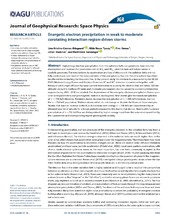Energetic electron precipitation in weak to moderate corotating interaction region-driven storms
Ødegaard, Linn-Kristine Glesnes; Tyssøy, Hilde Nesse; Søraas, Finn; Stadnes, Johan; Sandanger, Marit Irene
Peer reviewed, Journal article
Published version

Åpne
Permanent lenke
https://hdl.handle.net/1956/16243Utgivelsesdato
2017-03Metadata
Vis full innførselSamlinger
Originalversjon
https://doi.org/10.1002/2016ja023096Sammendrag
High-energy electron precipitation from the radiation belts can penetrate deep into the mesosphere and increase the production rate of NOx and HOx, which in turn will reduce ozone in catalytic processes. The mechanisms for acceleration and loss of electrons in the radiation belts are not fully understood, and most of the measurements of the precipitating flux into the atmosphere have been insufficient for estimating the loss cone flux. In the present study the electron flux measured by the NOAA POES Medium Energy Proton and Electron Detectors 0° and 90° detectors is combined together with theory of pitch angle diffusion by wave-particle interaction to quantify the electron flux lost below 120 km altitude. Using this method, 41 weak and moderate geomagnetic storms caused by corotating interaction regions during 2006–2010 are studied. The dependence of the energetic electron precipitation fluxes upon solar wind parameters and geomagnetic indices is investigated. Nine storms give increased precipitation of >∼750 keV electrons. Nineteen storms increase the precipitation of >∼300 keV electrons, but not the >∼750 keV population. Thirteen storms either do not change or deplete the fluxes at those energies. Storms that have an increase in the flux of electrons with energy >∼300 keV are characterized by an elevated solar wind velocity for a longer period compared to the storms that do not. Storms with increased precipitation of >∼750 keV flux are distinguished by higher-energy input from the solar wind quantified by the ϵ parameter and corresponding higher geomagnetic activity.
